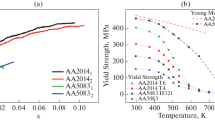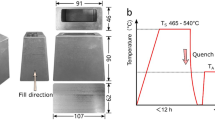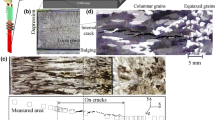Abstract
The residual stress distributions in two 7449 aluminium alloy rectilinear blocks have been determined using neutron diffraction. Heat treatment included cold water immersion quenching and a period of precipitation hardening. Quenching induced very high magnitude residual stresses into the two blocks. One block was measured in this condition while the other was incrementally machined by milling to half thickness. Neutron diffraction measurements were made on the milled half thickness block at equivalent locations to the unmachined block. This permitted through thickness measurements from both blocks to be compared, revealing the redistribution of residual stresses induced by machining. A square cross section post in the centre of the machined face was left to act as a stress free reference sample. The distortions arising on the face opposite to that being milled were measured using a co-ordinate measuring machine. The residual stresses and distortion arising in the blocks have been compared to finite element analysis prediction and found to generally agree. Material removal only caused distortion and the residual stresses to redistribute; there was no stress relaxation evident.














Similar content being viewed by others
References
Sim WM (2008) Challenges of residual stress and part distortion in the civil airframe industry. In: 2nd international conference on distortion engineering. Bremen, Germany
Brinksmeier E, Solter J, Grote C (2007) Distortion engineering—identification of causes for dimensional and form deviations of bearing rings. Cirp Annals-Manufacturing Technology 56(1):109–112
Tanner DA, Robinson JS, Cudd RL (2000) Relief of residual stresses in aluminium alloy 7010. In: Proceedings of the the sixth international conference on residual stresses ICRS-6, 10–12 July 2000. Institute of Materials, Oxford, UK, pp 1299–1306
Barker RS, Turnbull GK (1966) Control of residual stresses in hollow aluminium forgings. Metal Progress 60–65, Nov
Jeanmart P, Bouvaist J (1985) Finite element calculation and measurement of thermal stresses in quenched plates of high-strength 7075 aluminium alloy. Mater Sci Technol 1:765–769
Yazdi SR, Retraint D, Lu J (1998) Study of through-thickness residual stress by numerical and experimental techniques. J Strain Anal Eng Des 33(6):449–458
Yoshihara N et al (1992) Development of large high strength aluminium alloy component for spacecraft. NKK Techn Rev 64:21–27
Boyer JC, Boivin M (1985) Numerical calculations of residual stress relaxation in quenched plates. Mater Sci Technol 1:786–792
Prime MB, Hill MR (2002) Residual stress, stress relief, and inhomogeneity in aluminum plate. Scr Mater 46(1):77–82
Altschuler Y, Kaatz T, Cina B (1988) Mechanical relaxation of residual stresses. In: ASTM STP 993, pp 19–29
Bains T(1997) Residual stress reduction in aluminum die forgings. In: 1st international non-ferrous processing and technology conference. ASM International, St. Louis, Missouri, USA
Nickola WE (1988) Residual stress alterations via cold rolling and stretching of an aluminum alloy. In: ASTM STP 993, pp 7–18
Vohringer O (1987) Relaxation of residual stresses by annealing or mechanical treatment. In: Niku-Lari A (ed) Advances in surface treatments technology-applications-effects. Pergamon Press, pp 367–396
Becker R et al (1996) Distortion and residual stress in quenched aluminum bars. J Appl Mech-Trans Asme 63(3):699–705
Lynch JJ(1951) The measurement of residual stresses. In: Thirty-third national metal congress and exposition. American Society of Metals, Detroit
Treuting RG, Read WT (1951) A mechanical determination of biaxial residual stress in sheet materials. J Appl Phys 22(2):130–134
Denkena B, de León L (2008) Machining induced residual stress and distortion in forged aluminium parts. In: 8th International Conference on Advanced Manufacturing Systems and Technology (AMST’08). Udine, Italy
Hibbitt HD, Karlsson B, Sorensen EP (2009) ABAQUS users manual. Providence, RI
Touloukian YS, Buyco H (1970) Specific heat: metallic elements and alloys. In: Thermophysical properties of matter. IFI/Plenum Press, New York
Touloukian YS et al (1970) Thermal conductivity: metallic elements and alloys. In: Thermophysical properties of matter. IFI/Plenum Press, New York
Trujillo DM (2003) INTEMP, TRUCOMP: FOUNTAIN VALLEY, CA., 92708, USA. p. Inverse Heat Transfer Analysis
Touloukian YS et al (1970) Thermal expansion: metallic elements and alloys. In: Thermophysical properties of matter. IFI/Plenum Press, New York
Handbook M (1981) Heat treating. In: Metals handbook. ASM International, pp 696–697
Jackson A (1992) Homogenisation effects on the hot working of Al-Zn-Mg-Cu alloys. University of London, London
Hofmann M et al (2006) The new materials science diffractometer STRESS-SPEC at FRM-II. Phys B Condens Matter 385–86:1035–1037
Hofmann M et al (2007) Scientific review: stress spec: advanced materials science at the FRM II. Neutron News 18(4):27–30
IS0/TTA3 (2001) Polycrystalline materials—determination of residual stresses by neutron diffraction. In: Technology trends assessment. International standardisation organisation
21432, DCIT (2005) Non-destructive testing. Standard test method for determining of residual stresses by neutron diffraction. British Standards Institute
Pirling T, Hughes DJ, Robinson JS (2009) Precise determination of residual stresses in large specimens. In: 5th international conference on mechanical stress evaluation by neutrons and synchrotron radiation (MECA SENS V). Mito, Japan
Hutchings MT et al (2005) Introduction to the characterisation of residual stress by neutron diffraction. CRC, Boca Raton, 424
Steuwer A et al (2007) The variation of the unstrained lattice parameter in an AA7010 friction stir weld. Acta Mater 55(12):4111–4120
Flynn RJ, Robinson JS (2003) The application of advances in quench factor analysis property prediction to the heat treatment of 7010 aluminium alloy. In: Proceedings of the international conference on advances in materials and processing technologies, AMPT2003. Dublin City University, Dublin, Ireland
Webster PJ et al (1996) Impediments to efficient through-surface strain scanning. J Neutron Res 3(4):223–240
Walker DM, Hom RY (2002) Residual stress analysis of aircraft aluminum forgings. Adv Mater Processes 160(6):57–60
Koc M, Culp J, Altan T (2006) Prediction of residual stresses in quenched aluminum blocks and their reduction through cold working processes. J Mater Process Technol 174(1–3):342–354
Prime MB, Newborn MA, Balog JA (2006) Quenching and cold-work residual stresses in aluminium hand forgings: contour method measurement and FEM prediction. In: THERMEC’2003: processing & manufacturing of advanced materials. Madrid, Spain
Wang QC et al (2003) Evaluation of residual stress relief of aluminum alloy 7050 by using crack compliance method. Trans Nonferrous Met Soc China 13(5):1190–1193
Lin GY et al (2003) Residual stress in quenched 7075 aluminum alloy thick plates. Trans Nonferrous Met Soc China 13(3):641–644
Zhang H et al (2003) Influence of quenchant factors on residual stresses in quenched 7075 aluminium-alloy thick plate. Heat Treat Met 30(3):61–64
Robinson JS et al (2009) Influence of cold compression on the residual stresses in 7449 forgings. Adv X-Ray Anal 52:667–674
Davis JR, Davidson GM, Lampman SR (1995) Heat treating of aluminum, vol. 4. ASM International 841–879
Acknowledgements
This investigation has been supported by the European Commission under the 6th Framework Programme project known as COMPACT (AST4-CT-2005-516078), which contributes to the thematic priority “Strengthening Competitiveness” of the European aircraft industry. The residual stress measurements conducted on the STRESS-SPEC instrument at FRM II have also been supported by the European Commission under the 6th Framework Programme through the Key Actions: Strengthening the European Research Area, Research Infrastructures. Contract n°: RII3-CT-2003-505925.
Author information
Authors and Affiliations
Corresponding author
Rights and permissions
About this article
Cite this article
Robinson, J.S., Tanner, D.A., Truman, C.E. et al. Measurement and Prediction of Machining Induced Redistribution of Residual Stress in the Aluminium Alloy 7449. Exp Mech 51, 981–993 (2011). https://doi.org/10.1007/s11340-010-9389-4
Received:
Accepted:
Published:
Issue Date:
DOI: https://doi.org/10.1007/s11340-010-9389-4




